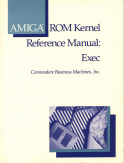![[Prev]](/images/blue_prev.gif)
![[Next]](/images/blue_next.gif)
![[Up]](/images/blue_up.gif)
![[Main]](/images/blue_toc.gif)
![[New]](/images/blue_new.gif)
![[Search]](/images/blue_search.gif)
![[Home]](/images/blue_home.gif)

Amiga ROM Kernel Reference Manual: Exec
second print
In English
Publisher: Addison-Wesley Publishing Company, Inc., July, 1986
ISBN: 0-201-11099-7 (Wikipedia Book Sources) (Wikipedian kirjalähteet)
LCCN: 86-10887 (Library of Congress)
The Amiga Computer is an exciting new high-performance microcomputer with superb graphics, sound, and multitasking capabilities. Its technologically advanced hardware, designed around the Motorola 68000 microprocessor, includes three sophisticated custome chips that control graphics, audio, and peripherals. The Amiga's unique system software is contained in 192K of read-only memory (ROM), providing programmers with unparalleled power, fexibility, and convience in designing and creating programs.
The AMIGA ROM KERNEL REFERENCE MANUAL: Exec, written by the technical staff at Commodore-Amiga, Inc., is a detailed description of Exec, the ROM-based multitasking system executive that controls the Amiga's underlying system execution environment. It includes:
- an overview of capabilities of Exec
- key descriptions of how Exec handles multitasking and inter-task communication
- explanations of Exec's exception handling and memory allocation
- a complete listing of the ROM routines that make up Exec
For the serious programmer working in assembly language, C, or Pascal who wants to take full advantage of the Amiga's impressive capabilities, the AMIGA ROM KERNEL MANUAL: Exec is an essential reference.
Written by the technical staff at Commodore-Amiga, Inc., who designed the Amiga's hardware and system software, the AMIGA ROM KERNEL MANUAL: Exec is the definitive source of information on the system execution environment of this revolutionary microcomputer.
Table of Contents| |
| PREFACE | v |
| System Software Architechture | v |
| Programming | vi |
| vi |
| vi |
| vii |
| 68010 AND 68020 COMPABILITY |
| ix |
| USING AMIGA EXEC FUNCTIONS |
| ix |
| Contents of This Manual | xi |
| |
| Chapter 1 LISTS AND QUEUES | 1 |
| Introduction | 2 |
| List Structure | 2 |
| 2 |
| 3 |
| 4 |
| 5 |
| List Functions | 6 |
| 6 |
| 7 |
| 7 |
| 7 |
| 8 |
| List Macros | 8 |
| Empty Lists | 9 |
| Scanning a List | 10 |
| |
| Chapter 2 TASKS | 11 |
| Introduction | 12 |
| 12 |
| 13 |
| 14 |
| 14 |
| 14 |
| Creation | 15 |
| 18 |
| Termination | 18 |
| Signals | 19 |
| 20 |
| 21 |
| 22 |
| Exclusion | 22 |
| 22 |
| 23 |
| 25 |
| Exceptions | 25 |
| Traps | 26 |
| 27 |
| 27 |
| |
| Chapter 3 MESSAGES AND PORTS | 29 |
| Introduction | 29 |
| Ports | 30 |
| 30 |
| 32 |
| 33 |
| 33 |
| Messages | 33 |
| 34 |
| 35 |
| 36 |
| 37 |
| |
| Chapter 4 INPUT/OUTPUT | 39 |
| Introduction | 39 |
| Request Structure | 40 |
| Interface Functions | 43 |
| Standard Commands | 44 |
| Performing I/O | 45 |
| 45 |
| 46 |
| 47 |
| 48 |
| 48 |
| Standard Devices | 49 |
| |
| Chapter 5 INTERRUPTS | 51 |
| Introduction | 51 |
| 52 |
| 53 |
| 55 |
| Servicing Interrupts | 55 |
| 55 |
| 56 |
| 56 |
| 60 |
| Software Interrupts | 62 |
| Disabling Interrupts | 63 |
| |
| Chapter 6 MEMORY ALLOCATION | 65 |
| Introduction | 65 |
| Using Memory Allocation Routines | 66 |
| 66 |
| 67 |
| SAMPLE CALLS FOR ALLOCATING SYSTEM MEMORY |
| 68 |
| SAMPLE FUNCTION CALLS FOR FREEING SYSTEM MEMORY |
| 68 |
| ALLOCATING MULTIPLE MEMORY BLOCKS |
| 69 |
| Memory Allocation and Tasks | 71 |
| MEMORY ALLOCATION AND MULTITASKING |
| 72 |
| MANAGING MEMORY WITH ALLOCATE() AND DEALLOCATE() |
| 72 |
| |
| Chapter 7 LIBRARIES | 75 |
| What is a Library? | 76 |
| How to Access a Library | 76 |
| 76 |
| USING A LIBRARY TO CALL A ROUTINE |
| 77 |
| USING A LIBRARY TO REFERENCE DATA |
| 78 |
| 78 |
| 79 |
| Adding a Library | 79 |
| 79 |
| MINIMUM SUBSET OF LIBRARY CODE VECTORS |
| 80 |
| STRUCTURE OF A LIBRARY NODE |
| 81 |
| CHANGING THE CONTENTS OF A LIBRARY |
| 82 |
| Relationship of Libraries to Devices | 82 |
| |
| Chapter 8 ROM-WACK | 83 |
| Introduction | 83 |
| Getting to Wack | 84 |
| Keystrokes, Numbers, and Symbols | 84 |
| Register Frame | 85 |
| Display Frames | 86 |
| Relative Positioning | 87 |
| Absolute Positioning | 88 |
| Altering Memory | 89 |
| Execution Control | 91 |
| Breakpoints | 91 |
| Returning to Multitasking After a Crash | 91 |
| |
| Appendix A C EXEC INCLUDE FILES | A-1 |
| |
| Appendix B OTHER ROUTINES | B-1 |
| Exec Support Library | |
| Debug.lib Functions | |
| Amiga.lib Functions | |
| AmigaDOS General Information | |
| Interchange File Format | |
| |
| Appendix C MEMORY/DISK INFORMATION | C-1 |
| Software Memory Map | |
| Disk Format Information | |
| |
| Appendix D LIBRARY BASE OFFSETS | D-1 |
| |
| Index | Index-1 |
![[Prev]](/images/blue_prev.gif)
![[Next]](/images/blue_next.gif)
![[Up]](/images/blue_up.gif)
![[Main]](/images/blue_toc.gif)
![[New]](/images/blue_new.gif)
![[Search]](/images/blue_search.gif)
![[Home]](/images/blue_home.gif)
